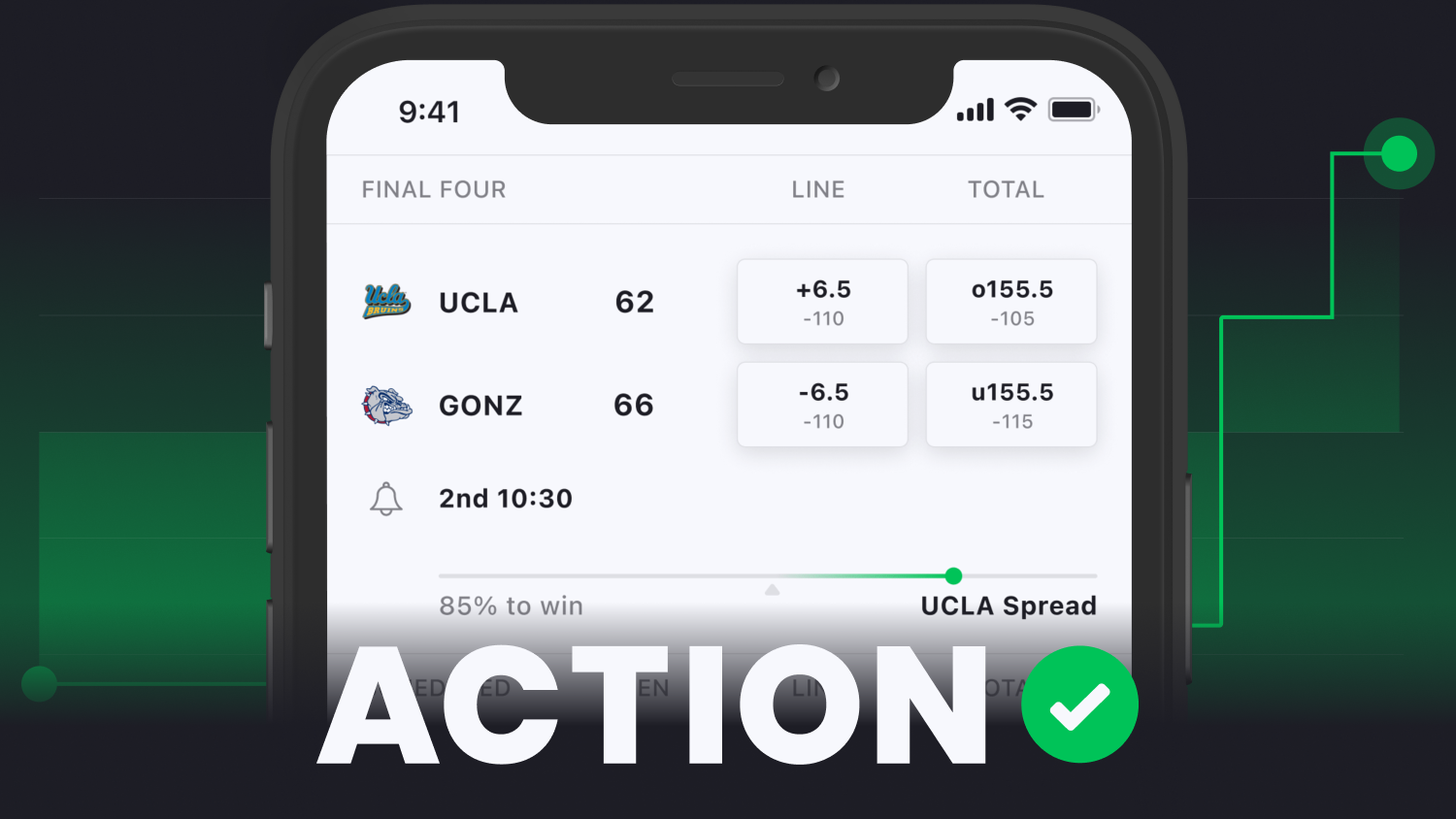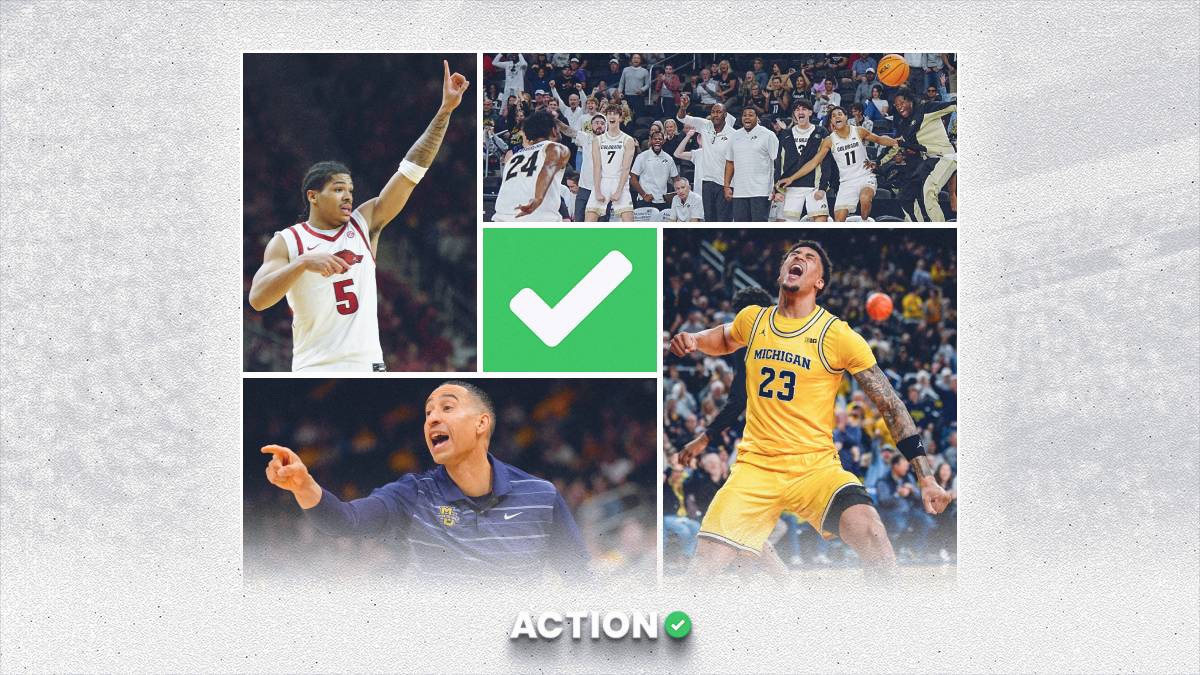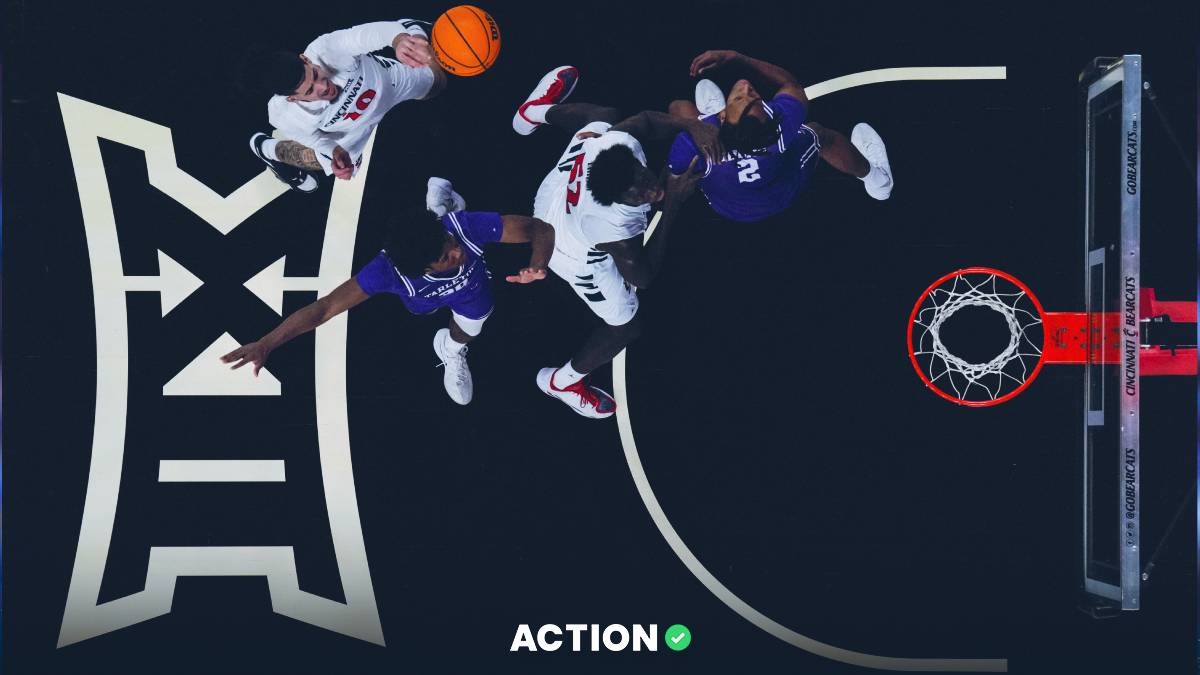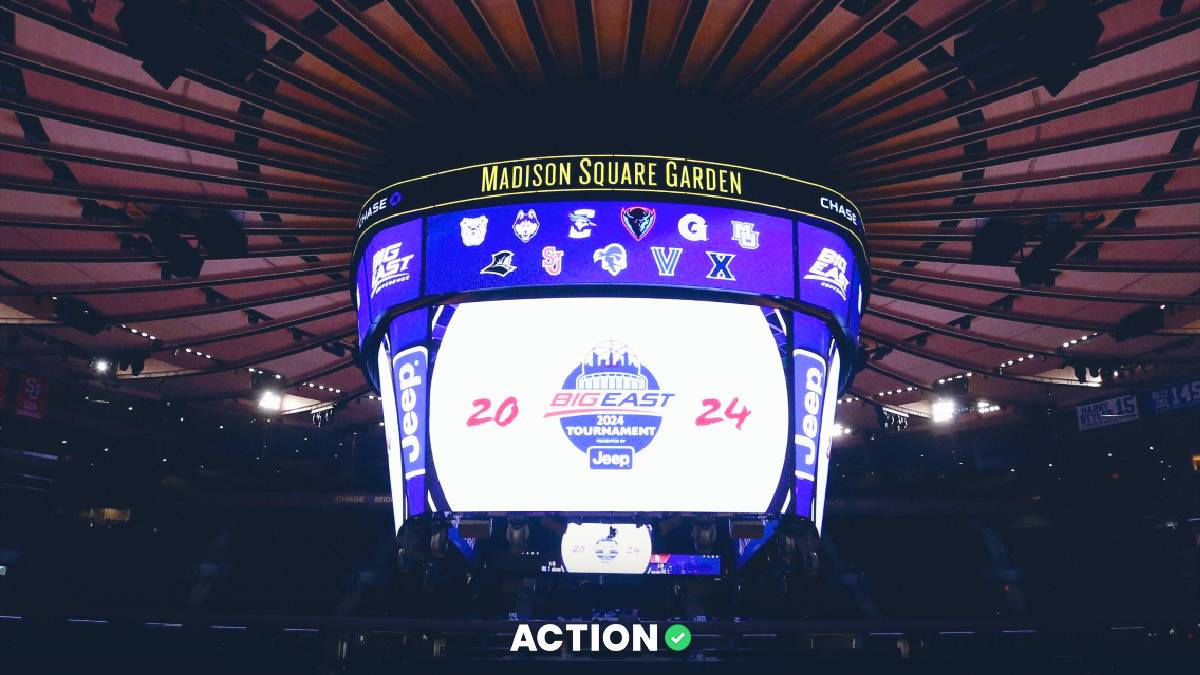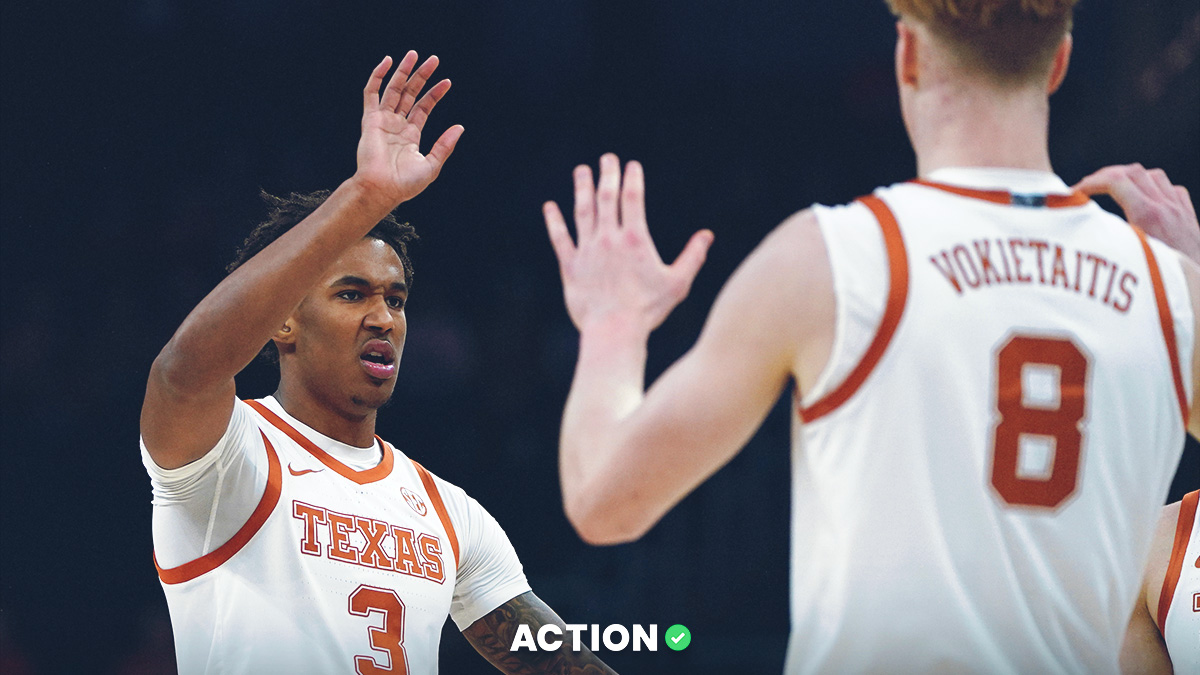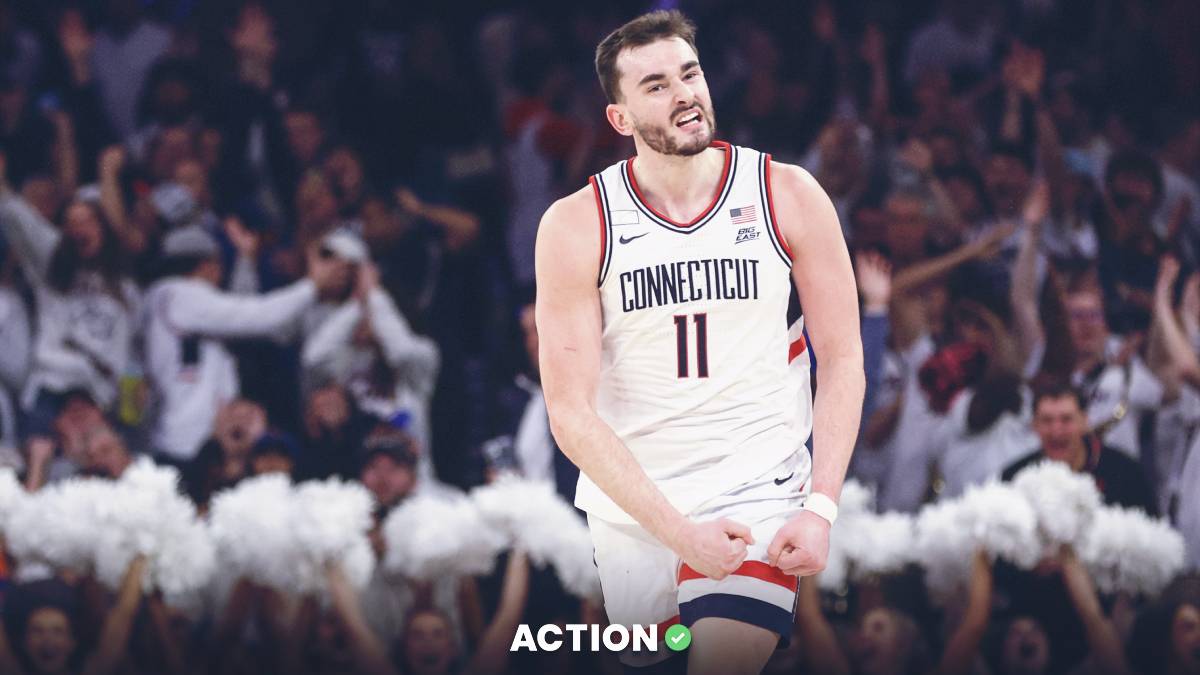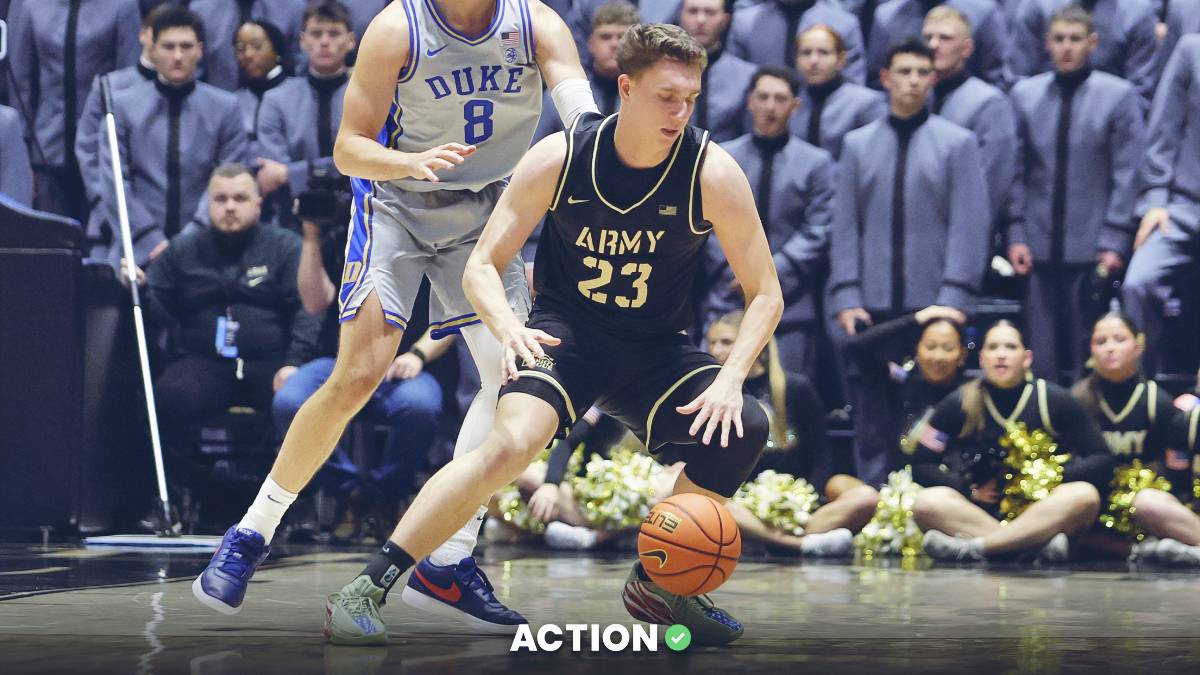Mike Calabrese and Tanner McGrath are back for another edition of our Pick & Roll. The dynamic duo has NCAAB picks and predictions for Saturday.
McGrath's 2 Saturday Picks
UNC vs. Virginia
Let’s start with a little history lesson.
Tony Bennett is among the most profitable coaches to bet on in college basketball history. He’s the third-most profitable coach overall in our Bet Labs database.
| Coach | ATS Record | Profit (Units) | ROI |
|---|---|---|---|
| Steve Alford | 307-245-7 | 43.4 | 7.8% |
| Tim Floyd | 179-137-7 | 33.5 | 10.4% |
| Tony Bennett | 274-224-10 | 33.4 | 6.6% |
| Roy Williams | 267-223-14 | 28.7 | 5.7% |
| James Jones | 203-161-8 | 28.6 | 7.7% |
| Jay Wright | 269-227-13 | 25.8 | 5.1% |
| Buzz Williams | 235-194-3 | 25.8 | 6.0% |
The Cavaliers are 105-83-3 (56%) ATS at home since Bennett took over in 2010, generating over 15 units of profit with an 8% ROI. That includes a 71-59-3 (55%) mark in ACC play.
Including three seasons at Wazzu, Bennett-led squads have closed as home ‘dogs 22 times, going 13-9 ATS with six covers in the past seven opportunities.
Following a loss, Bennett’s Virginia squads are 42-28-2, generating a 16% ROI.
And returning home after a 10-point-or-more defeat, the Bennett-led Cavaliers are 6-2 ATS. Following a 15-point-or-more defeat, they’re a perfect 4-0, covering by an average margin of 11 points.
Virginia is back home on Saturday after getting crushed by 34 in Blacksburg on Monday, hosting AP No. 10-ranked North Carolina.
Ranked teams have struggled on the road this year.
Among those ranked woes, the Heels have struggled traveling over the past month, losing two of three and dropping games against lowly Georgia Tech and Syracuse while squeaking out a three-point victory over a reeling Miami squad. North Carolina boasts a +25 Net Rating in Chapel Hill this year and a +9 anywhere else.
Saturday’s situational spot screams Virginia.
But I also love the schematic matchup for the Hoos.
North Carolina runs what I like to call a pace-and-post offense. The Heels run the floor with the elite guard trio of Elliot Cadeau, RJ Davis and Cormac Ryan, and their job is to push the pace while dumping the ball to Armando Bacot in the low post.
When they’re not running pace-and-post, the backcourt runs perimeter off-ball screens to make space for Davis to work – the senior is a supernova shot-creator in space.
And when they’re not making shots, the Heels lead the ACC in offensive rebounding rate, generating 12 second-chance points per game.
The Heels are good at what they do. They rank second in the league in offensive efficiency, third in fast-break points per game (12) and third in post-up points per game (8).
But the Heels aren’t perfect. They struggle when the game doesn’t go according to plan.
For example, three of North Carolina’s six losses this year coincide with three of its five worst transition performances. The Heels scored only six fast-break points in a nine-point loss to UConn, six in a two-point loss to Villanova and seven in a four-point loss to Clemson.
For all their offensive woes, the Cavaliers can still play defense, ranking fourth in the conference in defensive efficiency.
And they have all the tools to throw North Carolina off script.
For starters, the Cavs are an elite transition defense. They lead the nation in transition possessions per game allowed (6.8) and rank in the top 10 in fast-break points per game allowed (5.9).
They play excruciatingly slow (last nationally in Adjusted Tempo), and it’s almost impossible to speed them up – only three teams have managed double-digit fast-break points against Virginia, including only one conference opponent (Memphis, NC Central and Virginia Tech).
Additionally, Bennett’s pack-line defense excels in the gaps, so getting the ball in the low block is tough.
And if Cadeau manages to squeak the ball through to Bacot, the big man will be met with an elite post defense, as Virginia leads the ACC in paint points per game allowed (24) and block rate (15%) while ranking well above D-I average in post-up PPP allowed (.78, 80th percentile).

Blake Buchanan and Jordan Minor are two hard-nosed interior defenders who can hang. And they spearhead a defensive rebounding unit that ranks third in the conference in second-chance points per game allowed (eight). They'll keep Bacot from dominating the post or volley-balling the offensive glass.
Finally, as mentioned, Bennett’s pack-line defense excels in the gaps, denying space to work. The Cavs rank in the top-30 nationally in off-ball screen PPP allowed (.72), so I can’t imagine Davis being awarded free range to find his favorite shots.
I doubt North Carolina finds any consistency or comfort on offense, especially in Charlottesville, where the Heels are 2-12 ATS over the past two decades while riding an eight-game outright losing streak.
North Carolina has played two games at Virginia since Hubert Davis took over in 2021, losing both while failing to reach the 60-point mark in either contest.
The Heels scored seven points on eight transition possessions (.87 PPP) across the two matchups. Bacot scored four points on 2-for-4 shooting across 21 minutes in the second trip.
On the other end of the court, Virginia’s offense is pitiful. The only reason the Cavs have hung around in the ACC standings is thanks to unsustainable 3-point shooting (39%).
However, Bennett is well known for his blocker-mover motion offense, trademarked by his dad, prioritizing off-ball screen, cutting and isolation sets. No college hoops team runs more off-ball screen possessions per game than Virginia’s 12.
Meanwhile, the Heels aren’t a model secondary defense. They’ve allowed the 10th-most points to off-ball screen sets (116 at 1.1 PPP) nationally and the 10th-most points to isolation scorers (137 at .92 PPP).
They tried a switch-everything coverage scheme against UConn’s pattern motion offense in the non-con, which has traditionally stymied Dan Hurley’s offense. But they were consistently confused and confounded by the Huskies’ elite player and ball movement, making endless coverage mistakes while allowing 27 points to 18 secondary actions (1.5 PPP).
For example, check out this Ghost screen set run by Cam Spencer and Alex Karaban:
This is just a coverage mishap from North Carolina. Jae’Lyn Withers likely wants Davis to switch to Karaban here, but he’s completely lost.
Not to drag Davis, but here’s another example of him defending way behind the UConn curve:
As Spencer flips the ball to Hassan Diarra, Seth Trimble switches from the former to the latter. Davis, however, is hesitant on his switch assignment, and a Samson Johnson flare screen blows him up before he fouls Spencer on the triple attempt.
The Heels did their best, but they’re a sub-par secondary defense – they’ve allowed the 10th-most points to off-ball screen sets (116 at 1.1 PPP) nationally – and the Hoos can exploit that.
In their last home matchup with North Carolina, the Cavs scored 27 points on 37 secondary actions (.73 PPP). That isn’t great, but it’s enough for an offensively-challenged, defensively-elite squad to scrape together a 65-58 victory.
Virginia matches up well stylistically with North Carolina, and the Cavs should produce their best effort after getting obliterated by their in-state rival earlier this week.
Meanwhile, we can bank on a road effort from the Heels, who should, at the minimum, flirt with their ninth straight road loss to UVA.
Hubert Davis hasn’t beaten Bennett on the road yet, and I'm betting it doesn't happen on Saturday.
Pick: Virginia +2.5
Want to learn what the best North Carolina sportsbook promos will be when North Carolina sports betting apps launch on March 11? Learn more.
Bryant vs. Vermont
From UVA to UVM, these teams have more in common than their acronyms.
Specifically, Vermont is also a snail’s pace team that viciously denies transition opportunities while refusing to get sped up. The Cats rank 349th nationally in Adjusted Tempo while leading the country in fast-break points per game allowed (5.4) and surrendering only .94 PPP on breakaway sets (84th percentile).
Coach John Becker talked to Chris Oliver about his unique transition defense mentality a few years ago:
The approach has been dynamite – this year more than ever.
America East basketball used to be about shot selection and defense. But the injection of Bryant and coaching changes at New Hampshire, Albany and NJIT have changed the league's composition.
The America East ranked 20th among the 32 conferences in tempo last season (67 possessions per game). This year, the conference is first (71), with four of the nation’s 25 fastest teams, and Lowell ranks in the top 90.
Four AmEast squads average double-digit fast-break points per game. An early February game between UMBC and Albany featured 37 transition possessions and 216 regulation points.
No, that’s not a typo. UMBC won 114-102 in regulation. The Retrievers and Danes combined for 153 field goal attempts and 40 free throws.
But the more things change, the more they stay the same.
Becker’s Cats still refuse to be sped up. Only two of 12 conference opponents have scored double-digit fast-break points, with Bryant and NJIT finishing right on 10.
Meanwhile, six of those 12 opponents have been held to three or fewer fast-break points, and the Cats allowed zero thrice in games against Binghamton, NJIT (the other matchup) and high-flying Albany.
Considering the year-over-year changes, Vermont’s transition denial metrics are almost unbelievable. The Cats have even survived a logo change.
I swear, I could scheme a better logo with a six-pack and three hours of Photoshop.
Despite my pre-conference season hesitation, Vermont hasn’t conceded its dynastic chokehold over the conference. Their most impressive stretch this year came in late January, when the Cats dispatched the two most dangerous threats to the throne — Bryant and UMass Lowell — in back-to-back road games.
And they did that through transition defense.
Lowell and Bryant are both up-tempo offenses, but Vermont held the pair to 22 transition points on 31 possessions, suitable for a paltry .70 PPP. Neither opponent broke the 60-point mark in regulation.
While Lowell was able to force overtime in its matchup by exploiting Vermont’s sometimes vulnerable interior defense and drawing 23 free-throw attempts, Bryant was essentially useless, managing 57 points at .76 PPP by shooting 22-for-53 (41%) from the field with more turnovers (11) than assists (nine).
I expect nothing different in the rematch, especially up in Burlington.
The Bulldogs are simply too transition-reliant to compete with the Cats. They rank second nationally in transition points per game (21) and top-40 in transition PPP (1.16).
But in three conference matchups with Becker’s sprint-to-the-hole, open-court defense, Bryant has generated 41 transition points on 48 run-outs (.85 PPP).
If Bryant ever wants to compete with Vermont, the Bulldogs will have to find success in other areas. Specifically, the Bulldogs want to score using handoffs to pop open their bevy of athletic, dangerous isolation scorers, like Sherif Gross-Bullock (18 PPG), Earl Timberlake (15 PPG) and Daniel Rivera (12 PPG).
Behind all that talent, the Bulldogs are a fantastic interior offense, leading the AmEast in 2-point shooting (55%) while scoring 35 paint points per game.
But Vermont leads the league in 2-point shooting allowed (45%) and paint points per game allowed (30), which includes denying handoff (.66 PPP allowed, 92nd percentile) and isolation (.69 PPP allowed, 78th percentile) sets.
I used to worry about Vermont’s interior defense, but anchor Ileri Ayo-Faleye is the frontrunner for AmEast DPOY, and Shamir Bogues is the best perimeter on-ball defender in the conference. Ileri ranks first among conference defenders in EvanMiya’s DBPR, while Bogues ranks fourth.
It's amazing how impactful Ileri is on the defensive end. He makes more astonishing, improbable defensive plays with each passing game.
Vermont will deny every Bryant transition opportunity, and the Catamount defenders can go punch-for-punch with the Bulldog attack in the half-court.
In the first head-to-head meeting this season, Bryant scored six points on 16 isolation and handoff sets (.38 PPP).
There’s simply nowhere for the Bulldogs to turn.
The best thing to happen to Bryant this year was the (some would say forced) resignment of former head coach Jared Grasso. First-year head coach Phil Martelli Jr. – yes, son of Michigan assistant Phil Martelli – installed a more aggressive man-to-man defense, leveraging interior athleticism to swat every shot possible.
After flailing on that end last season, Bryant ranks second in the AmEast in 2-point shooting allowed (46%) and first in block rate (15%). Timberlake, Rivera and Connor Withers are slapping every potential layup into the second row.
However, Vermont runs a perimeter-based, five-out motion offense that leads the conference in 3-point rate (44%). The Cats have run the same offense for a decade, slowly working the ball around the perimeter and hunting for a calculated shot From The Parking Lot, thus circumventing Bryant's defensive strength.
While Bryant’s interior defense has been top-notch, I question the Bulldogs' perimeter defense. They rank around the AmEast average in 3-point rate allowed and third-to-last in Open 3 Rate allowed.
In fact, Bryant’s been lucky on defense during conference play. Opponents are shooting only 29% on those mostly open 3s, while ShotQuality projects that number should be closer to 33% based on the “quality” of attempts allowed. Regression certainly looms.
But of more concern, Bryant’s significantly improved defense has struggled to contain motion sets. Specifically, the Bulldogs allow over 1.17 PPP to ball-screen roll-men (11th percentile).
That’s a problem against Vermont's five-out motion. When the Cats can’t find an open 3, they’ll shapeshift into ball-screen mode, trying to get Matt Veretto or Nick Fiorillo open behind the spaced-out defenders on a hard roll.
Vermont struggled to shoot the ball in the prior head-to-head meeting in Smithfield, canning only five of 25 attempts (20%). However, the Cats thoroughly exploited the Bulldogs’ questionable motion defense, scoring 13 points on seven roll-man possessions (1.85 PPP) and 14 points on seven post-up possessions (2.00 PPP).
Fiorillo was uber-prolific there, generating 11 of his 15 points on seven roll-man/post-up possessions (1.6 PPP).
Situationally, the spot screams Bulldogs. They most recently lost a home game to Lowell last Saturday, significantly hindering their chances of earning the AmEast tournament’s one-seed. They’ll have extra rest, considering they didn’t play a mid-week game while Vermont played on Thursday, and they’ll be extra motivated to even the season series while sneaking within one game in the standings.
However, the second-most impressive part of Vermont’s early two-game sweep over Lowell and Bryant was the Catamounts' depth. They legitimately run 10-deep, ranking in the top-50 nationally in bench minutes while leading the conference in bench scoring (24 PPG).
The added legs have been enormous this season, given the conference changed from a Wednesday-Saturday schedule to Thursday-Saturday. With nine 14-plus minutes per-game players – eight of whom have led the team in scoring at least once – any short-turnaround rest issues are minimized.
And I think Vermont will be similarly motivated to hold home court and sweep Bryant in both seasons since the Bulldogs joined the league. After Lowell upset Bryant in Smithfield last Saturday, a Vermont win here would essentially lock up the Cats’ eighth-straight regular-season title.
Vermont’s offense has stalled at times this year, but at its best, the Catamounts' shooting and ball movement are as lethal as ever. Nine Catamounts are shooting over 30% from 3, with Fairfield transfer TJ Long leading the way with 52 made at 35%.
They’re generating over 1.3 PPP (89th percentile) on seven (79th percentile) cutting sets per game.
With motivation and home-court advantage, I’d imagine Vermont cans three-level shots all night while denying Bryant every transition and half-court set in a dominant double-digit Patrick Gym victory.
I mean, it happens every time these two meet.
Pick: Vermont -8
The new ESPN Sportsbook is now online and you can use Action’s ESPN BET promo code TANBONUS for a new user welcome.
Calabrese's 2 Saturday Picks
UNC vs. Virginia
I'm actually going to oppose Tanner on this game.
There are two factors at play in this conference matchup between the Tar Heels and Cavaliers.
On one side you have Bennett’s performance at home as UVA’s head coach. Since arriving in Charlottesville, he’s established John Paul Jones Arena as a formidable home-court advantage.
Dating back to 2009, Bennett has covered 54.6% of his games as a home favorite, winning 84.5% of those contests straight up. That’s the best ATS performance as a home favorite in the ACC.
But this year’s Wahoo team is different.
According to Haslametrics, Virginia is not only the least consistent team in the conference, but it’s actually the least consistent team in America.
A big reason for this is the Cavaliers' shooting. They currently rank 278th in shooting efficiency and a baffling 352nd from the foul line (64.2%).
The formula for Bennett’s teams has revolved around stout interior defense, glacial pace and efficient offense. When one of those pillars crumbles, the whole operation comes tumbling down.
Virginia’s “Pack Line” defense is still good enough to crack the KenPom top 10, and UVA plays at the slowest pace in the nation (63 possessions per game). But this offense is so bad, that it’s struggled to crack 60 points in recent weeks.
It’s not even worth comparing UVA to its conference contemporaries. It’s more useful to note the teams that score more than Virginia on a nightly basis. Chicago State, Florida A&M, IUPUI and Tennessee Tech all have better offensive resumes than Virginia. Let that sink in for a second.
Bennett’s squad is coming off a loss in which it scored 0.67 points per possession, UVA's lowest figure in nearly two years.
A consequence of the Wahoo’s diminished play on the offensive end is that they’ve surrendered 10 “Kill Shots” this season. It’s rare for an elite defense to allow a 10-0 run against them, but this offense continually suffers droughts.
The Cavaliers’ recent nine-minute first-half scoreless streak against Virginia Tech demonstrates how lost they are on the offensive end. Only one other top-10 defense has surrendered more Kill Shots, and that’s 14-12 Rutgers.
Virginia’s only chance to win this game or cover a short number is to turn this game into an absolute rock fight. It was successful in doing exactly that against Wake Forest (49-47), but I believe North Carolina will exploit two UVA weaknesses and avoid a similar fate.
For starters, North Carolina will gobble up offensive rebounds, as it has all season long (10.6 OReb, 40th). The Cavs are decidedly mediocre on the defensive glass (73.7% 150th), despite decent overall size in their frontcourt.
The “Pack Line” defense will also dare UNC to beat them from deep, and I like that proposition for UNC (35.6% 3PT). Pitt knocked down 14 triples while upsetting UVA at home just last week, and opponents have averaged 10 3-pointers in UVA’s other six losses this season.
Hubert Davis was recently interviewed by The Juice Network, and made it clear that in addition to the Heels' work on the glass, he and his staff would be emphasizing getting to the line.
No team in the ACC attempts more foul shots per game than the Tar Heels, and that can help stabilize their scoring against an elite defense.
UNC men’s basketball coach Hubert Davis spoke with me on attacking UVA’s pack-line defense led by RJ Davis and Elliot Cadeau “We get to the free throw line more than anyone in the ACC; attacking the paint & living there” @TheJuiceNC#ACC#Tarheels#UNC 🏀🏀 pic.twitter.com/xkCfqMDUql
— Rio (@trueblue1824) February 20, 2024
And finally, I think this is a great buy-low spot on RJ Davis, who's in a bit of a shooting slump. The ACC’s leading scorer is shooting just 38% from the field in his past six games. What’s encouraging is that despite his struggles from the field, he’s still knocking down shots from outside the arc at a 41% clip.
I expect a 20+ point performance, three-to-four of his shots to fall from long range and a comfortable eight-to-10-point victory for North Carolina.
The Tar Heels need this win to keep pace with Duke in the ACC title race, so I foresee a focused, and energetic effort from Davis’ bunch on Saturday.
Pick: UNC -2.5
On March 11, the Tar Heel State will launch North Carolina sports betting fully online. Keep up with the latest legal happenings.
Villanova vs. UConn
From one rudderless offense to another. The toothless Wildcats head up to Storrs to face a suddenly motivated Huskies team — uh oh.
After UConn got run off the floor in Omaha, Dan Hurley made sure to make the most of the school’s first loss in two months. He called out his staff and his players, while personally taking responsibility for a poor coaching job. He clearly wanted to light a fire under his team after an uninspired effort.
This game is a pseudo-revenge spot in that Villanova nearly upset UConn down in South Philly a month ago. That one-point UConn win was a grind for Hurley’s team. The Huskies shot just 40% from the field and 29% from long-range.
The friendly confines of Gampel Pavilion should generate much higher success rates for the Huskies.
Villanova’s shooting, on the other hand, can't be trusted. The Wildcats struggle from the field (42.7 FG%, 256th) and don’t seem to have a sustainable game plan to make up for those shooting shortcomings. The Wildcats are 262nd in fast-break points per game (262nd) and find themselves in the bottom half of the conference in 3-point percentage.
And now they’re facing the best perimeter defense in the Big East; UConn is holding conference opponents to just 26% shooting from long range.
So, without a flurry of 3-pointers or buckets in transition, can Nova find other ways to win? Extra possessions are unlikely for the Cats, as they rarely force turnovers (256th) or generate second-chance opportunities on the glass (7.7 OReb, 266th).
And now that Donovan Clingan is playing at a higher level post-injury, there’s a good chance that UConn can widen the rebounding gap in this game.
Speaking of Clingan, since his minutes have increased in February, we’ve seen a huge jump in his overall production. Post foot injury, Clingan was averaging just 17 minutes per game in his first five games back on the floor.
Not only was that hurting his scoring impact (10 PPG), but his work as a screener in UConn’s motion offense was sorely missed. Once his minutes jumped up, starting on February 6, both Clingan’s production (12.2 PPG, 8.2 RPG, 2.8 BPG) and UConn’s offensive ceiling increased noticeably.
Both teams have demonstrated how much home-court advantage has meant to them in the past six weeks.
Villanova has regularly been blasted on the road, dropping recent contests to St. John’s by 20 and Marquette by 13. The Huskies, meanwhile, are ruthless at home, annihilating teams like Marquette, Xavier and Creighton by double-digits.
When UConn hosts a Big East opponent in the programs’ second meeting of the season, it's been masterful in the past year and a half. The Huskies are 8-1 SU in such scenarios and have covered six of the nine games against the spread.
They’ll make it seven of 10 here and boat race Nova at Gampel. I would play this up to -16.










